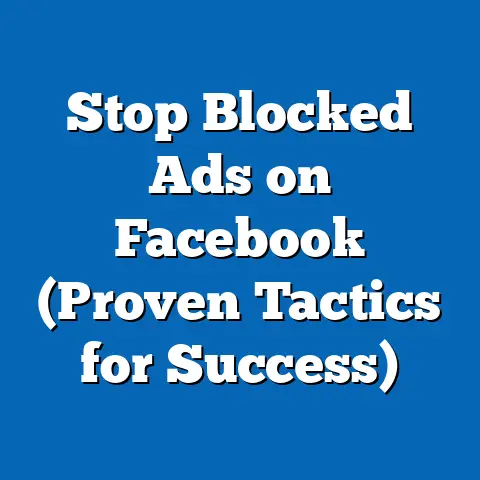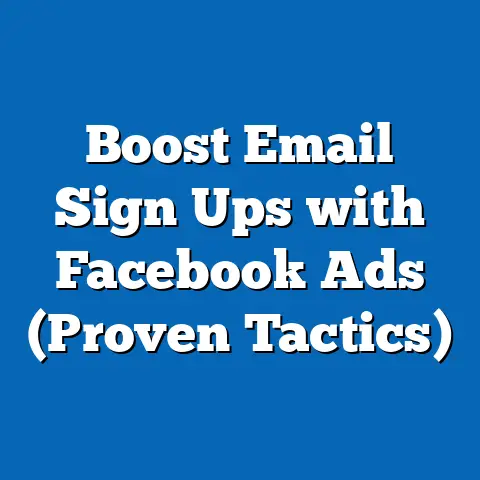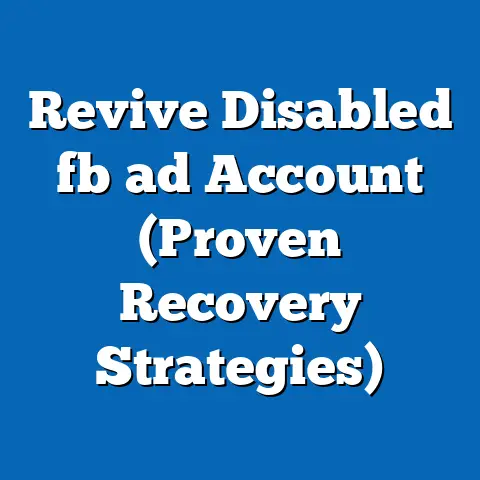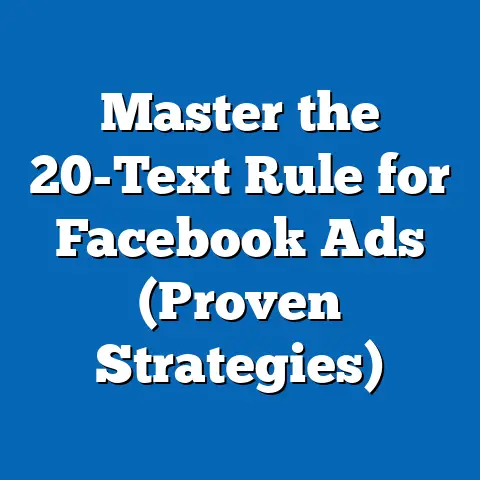Essential Facebook Support Email Tips (Expert Guide)
Have you ever felt like you’re shouting into the void when trying to get help from Facebook support? Trust me, I’ve been there. I remember one time when a client’s ad account was inexplicably suspended. We were hemorrhaging money, and every minute felt like an eternity. After days of generic responses, I realized I needed to overhaul my approach. That’s when I started meticulously crafting my support emails, and the results were astounding. A well-written email can be the difference between a swift resolution and endless frustration.
In this article, I’ll walk you through everything you need to know to communicate effectively with Facebook support. From understanding the different types of support services available to crafting compelling subject lines and avoiding common pitfalls, I’ll cover it all. You’ll learn how to gather the right information, structure your emails for maximum impact, and follow up professionally to ensure your issues are resolved quickly. So, let’s dive in and transform your Facebook support experience from frustrating to fruitful!
Section 1: Understanding Facebook Support Services
Facebook isn’t just a social media platform; it’s a multifaceted advertising ecosystem. As such, it offers various support services tailored to different needs. Understanding these services is the first step in ensuring your inquiries reach the right people.
Think of it like this: you wouldn’t go to a general practitioner for a heart problem, right? Similarly, you need to know where to direct your Facebook support requests.
Here’s a breakdown of the key support services you might encounter:
- Ads Support: This is your go-to for anything related to advertising on Facebook and Instagram. This includes issues with ad disapproval, campaign performance, targeting, and ad policies.
- Business Manager Support: If you’re managing multiple ad accounts, pages, and users through Business Manager, this is the team you’ll need. They can help with issues related to access, permissions, and account structure.
- Community Standards Support: For issues related to content violations, account security, or reporting abusive behavior, the Community Standards team is the appropriate contact.
- Payment & Billing Support: If you’re experiencing problems with your payment methods, billing cycles, or invoicing, this team can assist you.
- Technical Support: For technical glitches, API issues, or problems with Facebook’s platform, the technical support team is your best bet.
Common Issues and When to Contact Support
Let’s get specific. Here are some common scenarios where contacting Facebook support is essential:
- Ad Disapproval: Your ad gets rejected, and you’re not sure why.
- Account Suspension: Your ad account or Business Manager is suspended.
- Billing Errors: You’re charged incorrectly or experiencing payment issues.
- Campaign Performance Issues: Your ads aren’t performing as expected, and you need guidance.
- Policy Questions: You’re unsure if your ad complies with Facebook’s advertising policies.
- Technical Glitches: You’re encountering bugs or technical errors on the platform.
- Unauthorized Access: You suspect your account has been compromised.
Why Knowing the Right Support Matters
Reaching out to the wrong support team can lead to delays and frustration. Think of it as sending a letter to the wrong address – it might eventually get there, but it’ll take longer. By directing your inquiries to the appropriate team, you increase your chances of a faster and more effective resolution.
Takeaway: Before you even start drafting your email, identify the specific type of support you need. This will save you time and ensure your request reaches the right experts.
Section 2: Preparing to Reach Out
Before you start typing away, take a moment to gather your resources and understand the landscape. This preparation phase is critical for crafting an effective support email.
2.1 Gather Necessary Information
Think of this as your pre-flight checklist. Having the right information at your fingertips will make the support process smoother and faster. Here’s what you should gather:
- Ad Account ID: This is essential for any ad-related inquiries. You can find it in your Ads Manager.
- Business Manager ID: If your issue involves Business Manager, have this ID ready.
- Page ID: For page-related issues, grab the Page ID.
- Ad IDs: If you’re dealing with a specific ad, have its ID handy.
- Transaction IDs: For billing issues, collect the relevant transaction IDs.
- Screenshots: A picture is worth a thousand words. Capture screenshots of error messages, performance charts, or any other visual evidence that supports your claim.
- Previous Correspondence: If you’ve contacted support before about the same issue, include any previous ticket numbers or email threads.
- Detailed Description of the Issue: Write a concise summary of the problem you’re facing.
- Steps Taken to Resolve the Issue: Outline any troubleshooting steps you’ve already tried.
- Expected Outcome: Clearly state what you hope to achieve by contacting support.
Personal Experience: I once had a client whose ads were constantly being disapproved due to a “misleading claim.” After several frustrating exchanges, I realized I wasn’t providing enough context. I started including screenshots of the landing page, highlighting the specific text that might be misinterpreted. This simple addition drastically improved the speed and accuracy of the support team’s responses.
2.2 Understand the Support Response Structure
Facebook’s support system is structured to handle a massive volume of inquiries. Understanding how they categorize issues and prioritize responses can help you manage your expectations.
- Issue Categorization: Facebook categorizes issues based on their severity and complexity. Critical issues, such as account suspensions or billing errors, typically receive higher priority.
- Expected Response Times: Response times can vary depending on the issue and the volume of inquiries. While Facebook doesn’t guarantee specific response times, you can generally expect a response within 24-72 hours for critical issues and slightly longer for less urgent matters.
- Support Channels: Facebook offers support through various channels, including email, chat, and phone (for certain advertisers). Knowing which channel is most appropriate for your issue can expedite the process.
2.3 Setting the Right Tone
Believe it or not, the tone of your email can significantly impact the support team’s willingness to help. A professional, respectful, and clear tone can go a long way in getting your issue resolved quickly.
- Be Polite and Respectful: Remember, you’re communicating with a human being. Avoid being aggressive, demanding, or accusatory.
- Be Clear and Concise: Get straight to the point and avoid rambling.
- Use Proper Grammar and Spelling: This shows that you’re serious about your issue and respect the support team’s time.
- Avoid Using All Caps or Excessive Exclamation Points: This can come across as unprofessional and aggressive.
- Express Gratitude: Thank the support team for their time and assistance.
Takeaway: Preparation is key. Gather all the necessary information, understand the support response structure, and set the right tone before you start drafting your email. This will increase your chances of a positive and timely resolution.
Section 3: Structuring Your Email
Now, let’s get down to the nitty-gritty of crafting an effective support email. The structure of your email is crucial for conveying your message clearly and efficiently.
3.1 Subject Line
The subject line is your first impression. It’s what determines whether your email gets opened immediately or buried in the inbox. A compelling subject line should be:
- Clear: State the issue concisely.
- Specific: Avoid vague terms like “problem” or “issue.”
- Urgent (if applicable): If the issue is time-sensitive, indicate that in the subject line.
Examples of Effective Subject Lines:
- “Urgent: Ad Account [Your Ad Account ID] Suspended”
- “Billing Error: Transaction ID [Transaction ID] – Incorrect Charge”
- “Ad Disapproved: Ad ID [Ad ID] – Requesting Review”
- “Business Manager Access Issue: Unable to Add User”
- “Policy Question: Clarification Needed for [Specific Policy]”
Ineffective Subject Lines:
- “Help!”
- “Problem with my ads”
- “Urgent issue”
3.2 Salutation
The salutation sets the tone for the rest of your email. A professional and respectful greeting is always a good idea.
- Preferred: “Dear Facebook Support Team,” or “Dear Facebook Ads Support,”
- Acceptable: “Hello,” or “Hi,”
- Avoid: “Hey,” or informal greetings.
3.3 Opening Statement
Your opening statement should immediately grab the reader’s attention and introduce the issue succinctly.
- Example: “I am writing to request assistance with a suspended ad account, [Your Ad Account ID]. The account was suspended on [Date] and I have not received a clear explanation for the suspension.”
- Example: “I am contacting you regarding a billing error on my account. I was charged [Amount] for transaction ID [Transaction ID], which I believe is incorrect.”
3.4 Detailed Description
This is the heart of your email. Provide a clear, concise, and detailed description of the issue you’re facing.
- What Happened: Clearly explain the problem you’re experiencing.
- When it Happened: Provide the date and time the issue occurred.
- Any Error Messages Received: Include the exact error messages you encountered.
- Steps Taken to Resolve the Issue: Outline any troubleshooting steps you’ve already tried.
- Impact on Your Business: Explain how the issue is affecting your business or advertising efforts.
Example: “On [Date] at approximately [Time], my ad account [Your Ad Account ID] was suddenly suspended. I received the following error message: ‘[Exact Error Message]’. I have reviewed Facebook’s advertising policies and believe my ads are compliant. I have also tried [Troubleshooting Steps Taken] to resolve the issue, but the account remains suspended. This suspension is preventing me from running critical advertising campaigns, which is significantly impacting my business.”
Pro Tip: Use bullet points or numbered lists to organize your description and make it easier to read.
3.5 Call to Action
Your call to action should clearly state what you want the support team to do. Be polite and specific in your request.
- Example: “I kindly request that you review my ad account suspension and provide a detailed explanation for the suspension. I am confident that my ads comply with Facebook’s advertising policies, and I would appreciate it if you could reinstate my account as soon as possible.”
- Example: “I would appreciate it if you could investigate this billing error and issue a refund for the incorrect charge. I have attached a screenshot of the transaction for your reference.”
Takeaway: A well-structured email is clear, concise, and easy to understand. Use a compelling subject line, a professional salutation, a strong opening statement, a detailed description of the issue, and a clear call to action.
Section 4: Examples of Effective Emails
Let’s put theory into practice. Here are a few examples of well-structured emails tailored to different scenarios.
Example 1: Ad Disapproval
Subject: Ad Disapproved: Ad ID [Ad ID] – Requesting Review
Dear Facebook Ads Support,
I am writing to request a review of an ad that was recently disapproved. The ad ID is [Ad ID].
The ad was disapproved for violating the [Specific Policy Violated] policy. However, after reviewing the policy guidelines, I believe my ad is compliant. The ad promotes [Product/Service] and targets [Target Audience]. I have attached a screenshot of the ad and the landing page for your reference.
I believe the disapproval may be due to [Your Explanation for Why the Ad is Compliant].
I kindly request that you review my ad and provide clarification on why it was disapproved. If necessary, I am willing to make adjustments to ensure compliance.
Thank you for your time and assistance.
Sincerely,
[Your Name]
Analysis:
- Clear Subject Line: Immediately identifies the issue and includes the Ad ID.
- Specific: Mentions the specific policy violated and provides a reason why the ad is compliant.
- Attached Evidence: Includes screenshots for easy reference.
- Polite and Respectful: Maintains a professional tone throughout.
Example 2: Billing Issue
Subject: Billing Error: Transaction ID [Transaction ID] – Incorrect Charge
Dear Facebook Payment & Billing Support,
I am writing to report a billing error on my account. I was charged [Amount] for transaction ID [Transaction ID] on [Date].
I believe this charge is incorrect because [Your Explanation for Why the Charge is Incorrect]. I have reviewed my billing history and confirmed that this charge does not match any of my advertising campaigns.
I have attached a screenshot of my billing statement for your reference.
I would appreciate it if you could investigate this issue and issue a refund for the incorrect charge.
Thank you for your time and attention to this matter.
Sincerely,
[Your Name]
Analysis:
- Clear Subject Line: Identifies the issue and includes the Transaction ID.
- Specific: Provides details about the incorrect charge and explains why it’s incorrect.
- Attached Evidence: Includes a screenshot of the billing statement.
- Clear Request: Clearly states the desired outcome (a refund).
Example 3: Account Access Problem
Subject: Business Manager Access Issue: Unable to Add User
Dear Facebook Business Manager Support,
I am writing to report an issue with adding a user to my Business Manager account, [Your Business Manager ID].
I am attempting to add [User’s Name] with the email address [User’s Email Address] to my Business Manager account. However, I am receiving the following error message: ‘[Exact Error Message]’.
I have verified that the user does not already have access to my Business Manager account and that I have the necessary admin permissions.
I would appreciate it if you could investigate this issue and help me add the user to my Business Manager account.
Thank you for your assistance.
Sincerely,
[Your Name]
Analysis:
- Clear Subject Line: Identifies the issue and specifies that it’s related to Business Manager.
- Specific: Provides details about the user being added and the error message received.
- Troubleshooting Steps: Indicates that the user has verified the necessary permissions.
- Clear Request: Clearly states the desired outcome (adding the user to the Business Manager account).
Takeaway: These examples demonstrate how to structure your emails for different scenarios. Remember to be clear, specific, and polite in your communication.
Section 5: Common Pitfalls to Avoid
Even with the best intentions, it’s easy to make mistakes when contacting Facebook support. Here are some common pitfalls to avoid:
- Vague Descriptions of Issues: Avoid general terms like “problem” or “issue.” Be specific and provide as much detail as possible.
- Lack of Relevant Information: Make sure you include all the necessary information, such as ad account IDs, ad IDs, transaction IDs, and screenshots.
- Impatience in Follow-Up Emails: Avoid sending multiple follow-up emails in quick succession. Give the support team adequate time to respond.
- Being Aggressive or Demanding: Remember, you’re communicating with a human being. A polite and respectful tone is always more effective.
- Using All Caps or Excessive Exclamation Points: This can come across as unprofessional and aggressive.
- Ignoring Policy Guidelines: Before contacting support, review Facebook’s advertising policies to ensure your ads are compliant.
- Not Troubleshooting First: Try to resolve the issue yourself before contacting support. This shows that you’ve made an effort to find a solution.
- Not Providing a Clear Call to Action: Clearly state what you want the support team to do.
Personal Experience: I’ve seen countless advertisers sabotage their support requests by being overly aggressive or demanding. I once had a client who sent a series of angry emails to Facebook support, demanding an immediate resolution. Unsurprisingly, his issue remained unresolved for weeks. When I took over the communication and adopted a more polite and professional tone, the issue was resolved within 24 hours.
Takeaway: Avoiding these common pitfalls will significantly increase your chances of a positive and timely response from Facebook support.
Section 6: Follow-Up Strategies
Patience is a virtue, but sometimes, you need to nudge things along. Following up professionally is crucial for keeping the communication open and ensuring your issue doesn’t get lost in the shuffle.
- When to Follow Up: Generally, wait 24-72 hours before sending a follow-up email. If the issue is critical, you can follow up sooner.
- Keep it Concise: Your follow-up email should be brief and to the point.
- Reference Previous Correspondence: Include the original ticket number or email thread.
- Reiterate Your Issue: Briefly restate the issue you’re facing.
- Politely Request an Update: Ask for an update on the status of your request.
Example of an Effective Follow-Up Email:
Subject: Following Up: Ad Account [Your Ad Account ID] Suspended – Ticket # [Ticket Number]
Dear Facebook Ads Support,
I am writing to follow up on my previous email regarding the suspension of my ad account, [Your Ad Account ID]. The ticket number for my request is [Ticket Number].
As a reminder, my ad account was suspended on [Date] and I have not received a clear explanation for the suspension.
I would appreciate it if you could provide an update on the status of my request.
Thank you for your time and assistance.
Sincerely,
[Your Name]
Best Practices for Maintaining a Professional Demeanor:
- Avoid Being Demanding: Don’t demand an immediate resolution.
- Express Gratitude: Thank the support team for their time and effort.
- Be Patient: Understand that the support team is handling a large volume of inquiries.
- Avoid Sending Multiple Follow-Up Emails: Space out your follow-up emails to avoid overwhelming the support team.
Takeaway: Following up professionally is a crucial part of the support process. Be patient, polite, and persistent in your communication.
Conclusion
Communicating effectively with Facebook support is an essential skill for any advertiser. By understanding the different types of support services, preparing to reach out, structuring your emails effectively, avoiding common pitfalls, and following up professionally, you can significantly increase your chances of a positive and timely resolution.
Remember, a well-crafted email can be the difference between a swift resolution and endless frustration. By following the tips and strategies outlined in this guide, you can transform your Facebook support experience from frustrating to fruitful.
I encourage you to apply these tips and share your experiences with Facebook support. By sharing our knowledge and experiences, we can collectively improve the support process for everyone.
Call to Action
Now it’s your turn! Share your own experiences or additional tips in the comments section below. What strategies have worked for you when contacting Facebook support? Let’s create a community of shared knowledge and help each other navigate the often-challenging world of Facebook advertising.






